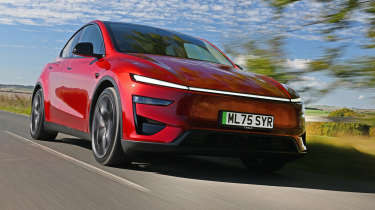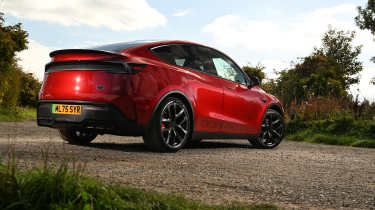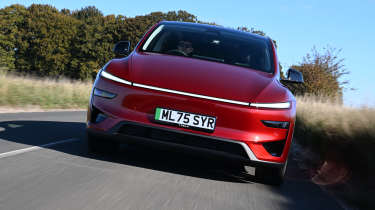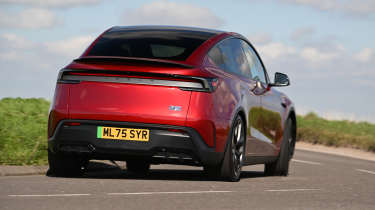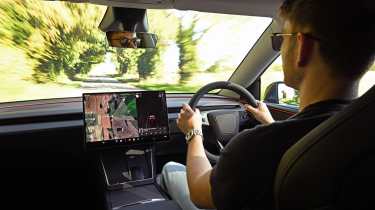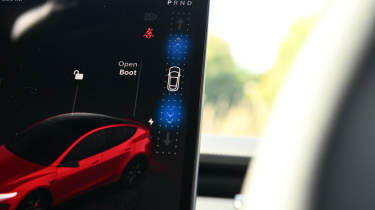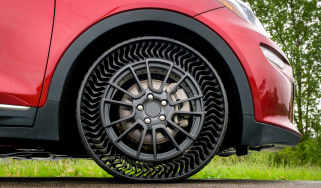Tesla Model Y Performance review – a Porsche Macan on a budget?
The range-topping Tesla Model Y Performance has the stats, and while it’s an impressive offering in many ways, rivals offer a more convincing dynamic package
The Tesla Model Y isn’t the sort of car we typically get excited about. All-electric and in a crossover body style, it’s the kind of everyday metal we wouldn’t blink an eye at, but its success is hard to ignore. The Model Y has been the UK’s best-selling EV for multiple years running, and among the top five best-selling cars altogether. Tesla gave the model a significant update in April and now, the range-topping Performance model has finally hit Britain’s roads.
Carried across from the standard car is its new exterior look, borrowing elements of the controversial Cybertruck with full-width front and rear lightbars while improving aerodynamic efficiency in the process. On the Performance, these are tweaked for a more aggressive aesthetic, with a more pronounced lower intake at the front and a re-worked rear bumper to create the illusion of a sportier diffuser. A lower ride height, larger 21-inch forged wheels and an extended carbonfibre lip spoiler also contribute to the design changes.
> Porsche Macan GTS electric SUV to rival the Tesla Model Y Performance
Updates go further than this with the Performance, with Tesla having worked on chassis stiffness, refinement and most importantly, the suspension setup. We’ve been behind the wheel to find out if this electric crossover can really deliver the ‘performance’ it promises.
Powertrain and technical highlights
Updated ‘4DU’ motors are mounted at either end of the Model Y Performance’s skateboard chassis, powered by a battery estimated to be 78kWh in capacity (Tesla doesn’t officially disclose this figure). Thanks to changes to its drive units, the new car has seen a moderate uplift in torque and power, with thermal management also better than before. Power output stands at 454bhp, 40bhp more than the previous car, and while this is still significantly less than some of its rivals, it certainly does the trick.
More reviews
The 0-62mph sprint is said to come in a very spritely 3.5sec, and it certainly feels that way from the driver’s seat. Acceleration is relentless from a standstill, hauling silently towards the speed limit without so much as a tyre chirp. While power in some EVs tails off once you’re on the move, pull remains just as strong from higher speeds here. It’s easy to see a c400bhp car as modest in a world of 1000bhp EVs, but the Model Y Performance is a very quick car no matter which way you look at it.
The most aggressive powertrain setting might be called ‘Insane’, but unlike some quick EVs the way it delivers this power is well measured and progressive, with the uncomfortable initial bite you sometimes get softened off in the case of the Model Y. Drop the drive mode down to standard and ‘Chill’ and it gets more relaxed still, with these tweaks making a noticeable difference to the way the powertrain responds. Turning traction control all the way off is not possible, but switching it to ‘reduced’ does allow for slightly more wiggle room than you’d have otherwise – traction control is well calibrated in this car and doesn’t spoil the fun in most scenarios on the road.
The same goes for regenerative braking, as even in ‘Standard’ mode (the mode in which you get the most regenerative braking), it won’t lurch forward should you jump off the pedal. Despite what some Tesla-owning Uber drivers might lead you to believe, the Performance is very easy to drive smoothly with one pedal – while previous Teslas haven’t allowed for this, regeneration can now be reduced through the menu system.
One of the Model Y’s key selling points is its range, and despite its increased power output the Performance is no different. Its WLTP combined range sits at 360 miles, a whole 81 miles more than the EV6 GT and not far from that of the Porsche Macan Electric with its much larger battery (and price). Tweaked aerodynamics will have contributed to this but Tesla says its battery has a higher power density than before, packing more power into a pack of the same weight. We began our journey with a full charge and a claimed 300-mile range, and despite a not-so-efficient driving style, the Model Y used less miles of range than the distance we covered – efficiency is quoted at 3.84mi/kWh, and we saw 3.4kWh during our time behind the wheel.
Performance, ride and handling
‘First class handling and speed’ is what Tesla’s aiming for with this car, and while the latter is certainly a strong point, we’re not so sure about the former. The Performance takes advantage of the increased rear-end body rigidity of the updated Model Y, combining it with tweaked adaptive suspension, a lower ride height, new springs, roll bars, bushings and supporting hardware in pursuit of a more capable overall package.
More capable than the previous car it certainly is, but there’s no mistaking this for a Porsche Macan. A kerbweight of 1958kg (DIN) makes it considerably lighter than the c2200kg Kia EV6 GT and even Stuttgart’s alternative, and while this might have some benefit to straight-line pace it still feels like a heavy car. A super responsive front end goes some way to masking this, but increase the pace and the Model Y yaws and pitches on trickier surfaces, with sudden and slightly disconcerting movements taking just that little bit too long to settle.
A set of EV-specific Pirelli P Zeros are standard-fit on its 21-inch forged ‘Arachnid’ wheels (available with or without the aero covers), 255-section at the front, 275 at the rear. Combined with a kinematics overhaul, these give it some serious grip when you need it, making it a quick car from point-to-point if you can work around its dynamic flaws.
The Model Y Performance doesn’t crash over bumps for the most part, but there’s no hiding the fact this is a Performance model – it’s a taut car even at low speeds, jostling you around on more significant imperfections on occasion. The suspension is adaptive and can be knocked back to ‘Comfort’ mode, but in our experience this makes little to no difference to ride quality.
> Kia EV6 GT 2025 review – Hyundai Ioniq 5 N parts make for a genuinely fun EV
The steering feels well weighted in its sportiest mode, but apply some lock and you’ll soon find that this resistance is oddly inconsistent from lock-to-lock. In some scenarios the change in weighting almost feels like a momentary loss of front end grip, and given the distinct lack of feel, it takes a moment to realise this isn’t the case. The middling ‘Standard’ steering mode is our favourite of the three, feeling the most natural, with the lightest mode only of real use in urban situations (where its excellent turning circle also comes in handy).
Regenerative braking might be well calibrated, but come to use the friction brakes and you’ll have a bit of a surprise. The pedal feels firm right from the top to inspire some initial confidence, but lean into the pedal and braking action is quite a bit more leisurely than you’d hope for a car capable of building speed at such a pace.
Interior and tech
The cabin is what will make or break this car for most people, as its approach is a radical one. The updated Model Y leans into the minimalist aesthetic of the original car with a flat, featureless horizontal dash mounted in-line with the belt-line to offer improved visibility and contribute to an airy feel – a standard-fit, full length panoramic sunroof also goes a long way in this department. There’s no instrument binnacle behind the wheel whatsoever, and there’s even just a single stalk on the column for the indicators (and indicators only).
A central 16-inch display (now slightly larger with thinner bezels and an improved resolution) is where quite literally everything happens in the Model Y Performance, being your primary way to select gears and displaying everything from your current speed and navigation. To engage drive, apply the brake and swipe up on a graphic on the top right of the display – if you don’t ever get used to this, Tesla has fitted touch-sensitive buttons to the light panel in the roof as an alternative.
Dive into that central display and it can seem a little overwhelming at first, but numerous windows, a static lower bar for frequently accessed apps, and settings split up into distinct sub-menus makes it easier to navigate than you might think – just about everything important is accessible within one to two taps. Even rear seat passengers get an 8-inch tablet as standard, allowing for access to climate control and entertainment.
Thankfully, that central display is responsive and solid to the touch, and this theme continues through the cabin. There’s not much to the cabin on a Model Y, but everything feels reasonably well put together, with material choices strong for the most part. The Performance gets real dry carbonfibre trim on the door cards, for example, which makes the faux carbonfibre on something like a £110,000 Audi RS6 look a little silly.
The Performance also differs from the standard car through its use of new front and rear seats, designed to offer more support than the standard kind – these come in either white or black and now have powered thigh adjustment for improved comfort. We must admit though, they don’t offer us much support at all. For perspective, the diesel Mercedes-Benz G-class we drove to the launch event had significantly more lateral support. The seating position also isn’t perfect for my taste, with the seat not quite dropping low enough.
They say this is the most refined Model Y yet, and we believe it. Glass is double layered for not just the front windows, but the rear windows too, with further changes made throughout to contribute to a more refined experience. Tyre noise occasionally encroaches on select surfaces thanks to wide 275-section rears, but it really is a quiet car for the segment with its excellent standard 15-speaker sound system making good use of this.
For UK buyers, the divisive ‘Full Self Driving’ system is not yet available (although is in testing), so the Model Y is effectively limited to adaptive cruise control and auto steer on dual carriageways for now. The camera system behind this tech is good at detecting road signs, markings and other cars, although a lack of Radar means it can think objects are closer than they really are, making for rather annoying and unnecessary warning sounds…
Price, specs and rivals
Starting from £61,990, the Tesla Model Y Performance is £17,000 more than the base Model Y, and sits in-line with numerous rivals. The Porsche Macan Electric starts from a higher £68,500, but for that money you get almost 100bhp less, a much slower 5.7sec 0-62mph time and 137mph top speed. Stuttgart’s closest model on paper is the 509bhp Macan 4S Electric, capable of a 4.1sec 0-62mph time and a slightly better 378-mile WLTP range than the Tesla. While the Porsche is considerably more expensive than the Model Y Performance spec-for-spec, it's a much more premium product, with this polish carrying through to its dynamics.
In the other corner of the market is the Kia EV6 GT, an impressive offering with considerably more power than the Tesla at 641bhp, sharing its powertrain with the Hyundai Ioniq 5 N. Despite the power advantage, its 0-62mph matches the Tesla at 3.5sec, and it actually undercuts the Model Y Performance marginally in terms of price at £59,985. The excellent Hyundai Ioniq 5 N (our favourite driver’s EV on sale) makes the Tesla look especially unappealing as a driver’s car, with its £65,000 starting price not much more (you’ll just have to put up with its 280-mile range).
First deliveries of the new Tesla Model Y Performance begin at the end of October, with all European-market cars set to be built at the firm’s Berlin-Brandenburg facility.
Tesla Model Y Performance specs
| Powertrain | Dual-motor all-wheel drive |
| Power | 454bhp |
| Torque | TBC |
| Weight | 1958kg (DIN) |
| Range | 360 miles (WLTP) |
| Power-to-weight | 232bhp/ton |
| 0-62mph | 3.5sec |
| Top speed | 155mph |
| Basic price | £61,990 |
